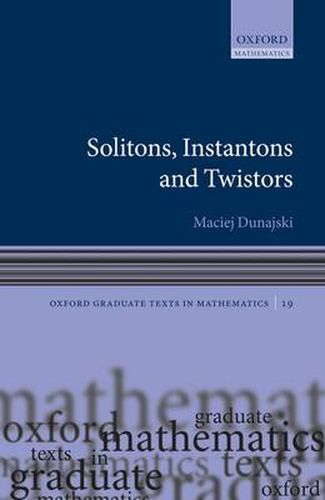Readings Newsletter
Become a Readings Member to make your shopping experience even easier.
Sign in or sign up for free!
You’re not far away from qualifying for FREE standard shipping within Australia
You’ve qualified for FREE standard shipping within Australia
The cart is loading…






Most nonlinear differential equations arising in natural sciences admit chaotic behaviour and cannot be solved analytically. Integrable systems lie on the other extreme. They possess regular, stable, and well behaved solutions known as solitons and instantons. These solutions play important roles in pure and applied mathematics as well as in theoretical physics where they describe configurations topologically different from vacuum. While integrable equations in lower space-time dimensions can be solved using the inverse scattering transform, the higher-dimensional examples of anti-self-dual Yang-Mills and Einstein equations require twistor theory. Both techniques rely on an ability to represent nonlinear equations as compatibility conditions for overdetermined systems of linear differential equations.The book provides a self-contained and accessible introduction to the subject. It starts with an introduction to integrability of ordinary and partial differential equations. Subsequent chapters explore symmetry analysis, gauge theory, gravitational instantons, twistor transforms, and anti-self-duality equations. The three appendices cover basic differential geometry, complex manifold theory, and the exterior differential system.
$9.00 standard shipping within Australia
FREE standard shipping within Australia for orders over $100.00
Express & International shipping calculated at checkout
Most nonlinear differential equations arising in natural sciences admit chaotic behaviour and cannot be solved analytically. Integrable systems lie on the other extreme. They possess regular, stable, and well behaved solutions known as solitons and instantons. These solutions play important roles in pure and applied mathematics as well as in theoretical physics where they describe configurations topologically different from vacuum. While integrable equations in lower space-time dimensions can be solved using the inverse scattering transform, the higher-dimensional examples of anti-self-dual Yang-Mills and Einstein equations require twistor theory. Both techniques rely on an ability to represent nonlinear equations as compatibility conditions for overdetermined systems of linear differential equations.The book provides a self-contained and accessible introduction to the subject. It starts with an introduction to integrability of ordinary and partial differential equations. Subsequent chapters explore symmetry analysis, gauge theory, gravitational instantons, twistor transforms, and anti-self-duality equations. The three appendices cover basic differential geometry, complex manifold theory, and the exterior differential system.